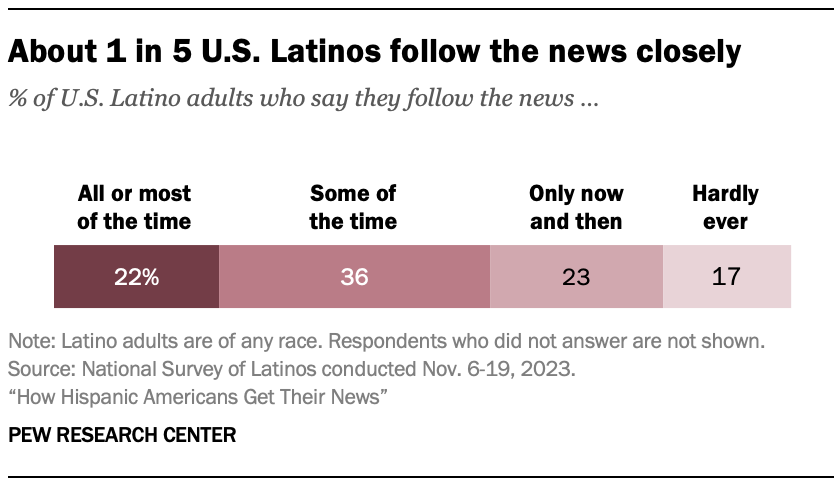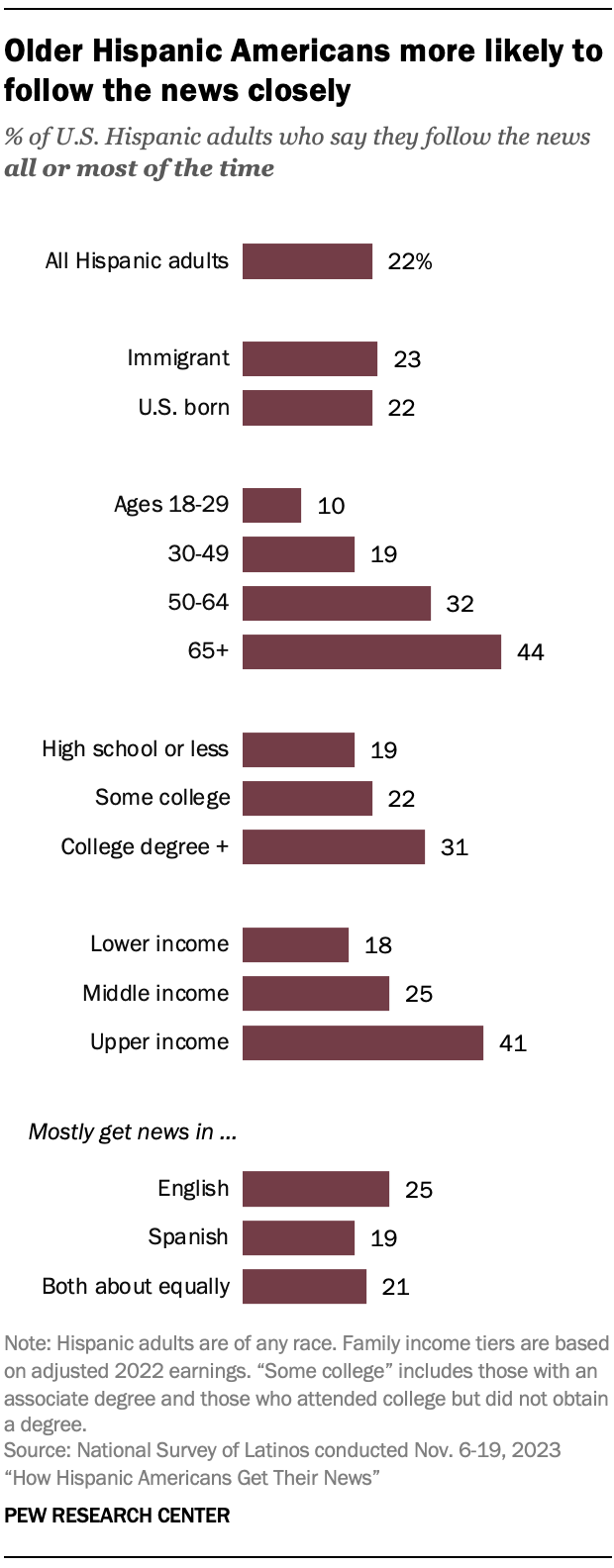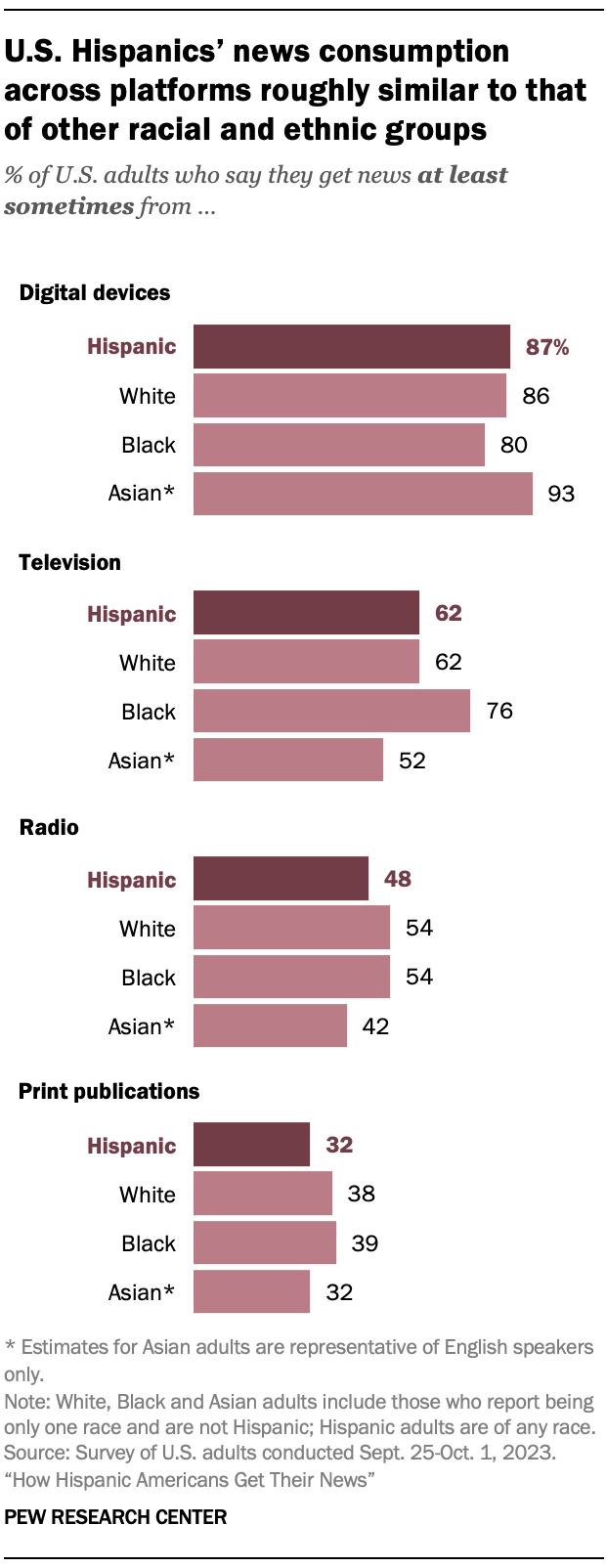
About one-in-five Hispanic adults (22%) say they follow the news all or most of the time, down from 28% in 2022. The share of U.S. adults overall who say they closely follow the news also has been declining.
Although we did not ask this question of the overall U.S. population in 2023, Latinos were less likely than White and Black Americans to say they closely follow the news in previous years. In 2022, for example, 43% of White adults and 35% of Black adults said they follow the news all or most of the time, compared with 28% of Latino adults.
These differences are at least partially due to age. Hispanic adults tend to be younger than White and Black adults, and younger people are less likely to follow the news closely.
Like the general population, most U.S. Latinos say they follow the news less than closely: Around a third (36%) say they follow the news some of the time, while 23% say they do so only now and then. And 17% of Latinos say they hardly ever follow the news.

Demographic patterns in news consumption among Latino adults parallel those seen in the broader U.S. population:
- Older Latino adults are much more likely than their younger counterparts to say they follow the news all or most of the time.
- Latino adults with higher levels of income and formal education are more likely than those with lower levels of income and education to say they closely follow the news. These patterns persist even when accounting for age.
There also are modest differences by language of news consumption. A quarter of Latinos who get their news mostly in English say they follow the news all or most of the time, compared with 19% of those who get news mostly in Spanish.
And 21% of Latinos who get news in both languages equally say they closely follow the news. There are no significant differences by overall language proficiency. English-dominant (22%), Spanish-dominant (21%) and bilingual (24%) Latinos closely follow the news at similar rates.
Where do Hispanic Americans get news?

In a separate Center survey from fall 2023, we looked at how often U.S. adults get news from different platforms. Hispanic Americans and other racial and ethnic groups say they turn to various platforms for news at similar rates.
By far the most common way that U.S. Hispanics – and Americans overall – get news is from a smartphone, computer or tablet. Nearly nine-in-ten Hispanic adults (87%) say they often or sometimes get news from digital devices. This includes getting news from search engines (74% say they do so at least sometimes), news websites or apps (60%), social media (56%) and podcasts (31%).
About six-in-ten Hispanic adults (62%) say they get news from television at least sometimes. Nearly half (48%) turn to radio at least sometimes for news, and 32% say the same about print publications.
The survey also asked people how they prefer to get news. On that question, Hispanic Americans are somewhat more likely than Black and White Americans to prefer digital devices for news: Nearly two-thirds of Hispanic adults (65%) say they prefer to get news on a digital device over other platforms, compared with 55% of White adults and 50% of Black adults. (At 78%, English-speaking Asian adults are even more likely to prefer digital devices.)

Hispanic Americans also are more likely than Black and White Americans to prefer social media in particular for news. Roughly one-in-five Hispanic adults (21%) say they prefer social media for getting news, while 13% of Black Americans and 10% of White Americans say the same. English-speaking Asian Americans prefer social media at a similar rate to Hispanic Americans (19%).
Some differences extend to specific social media sites, too. For example, 29% of Hispanic adults say they regularly get news on Instagram, and 25% say the same about TikTok. Just 9% of White Americans say they regularly get news on each site.
Once again, these patterns are at least partially due to the relatively young age of the Latino population. Younger people prefer digital devices and social media for news at higher rates. Among Latino adults ages 18 to 49, 73% prefer to get their news on digital devices, including 27% who prefer social media specifically. Among Latinos ages 50 and older, 43% prefer digital devices and just 5% prefer social media.
Similar shares of Latino adults under 50 and all U.S. adults under 50 prefer digital devices for news. But these younger Latinos are somewhat more likely than all U.S. adults under 50 to prefer social media (27% vs. 20%).


